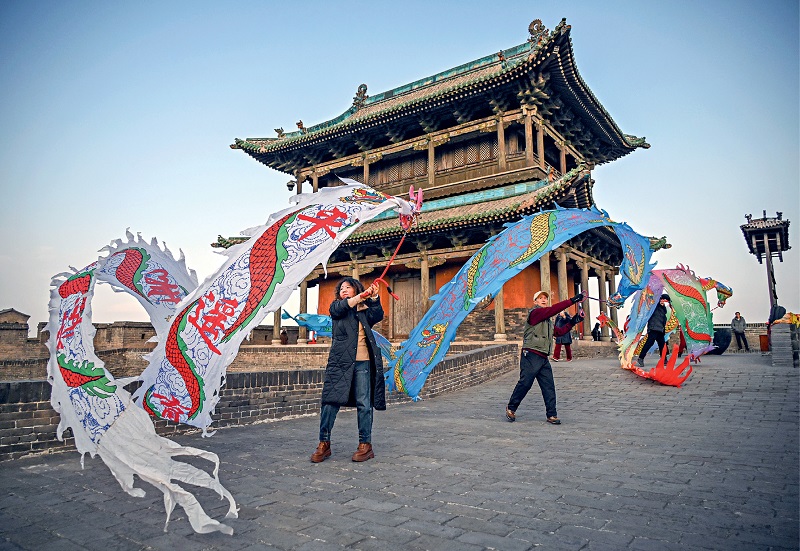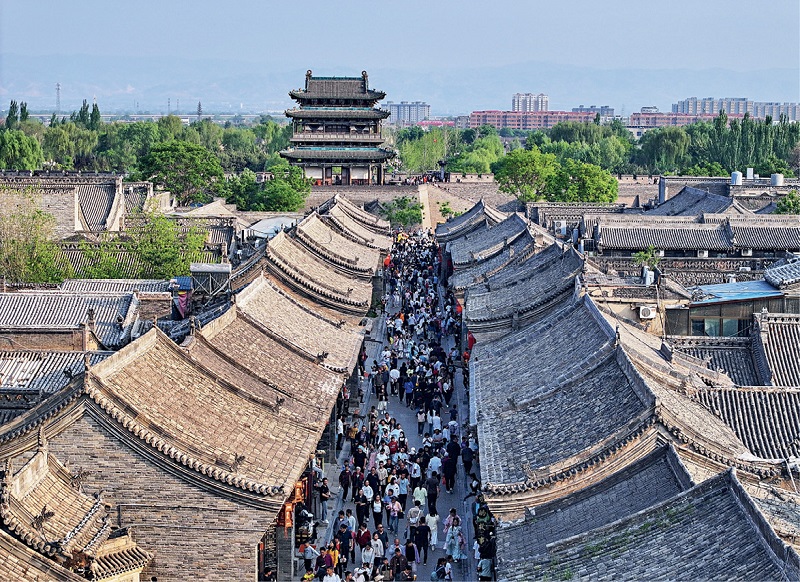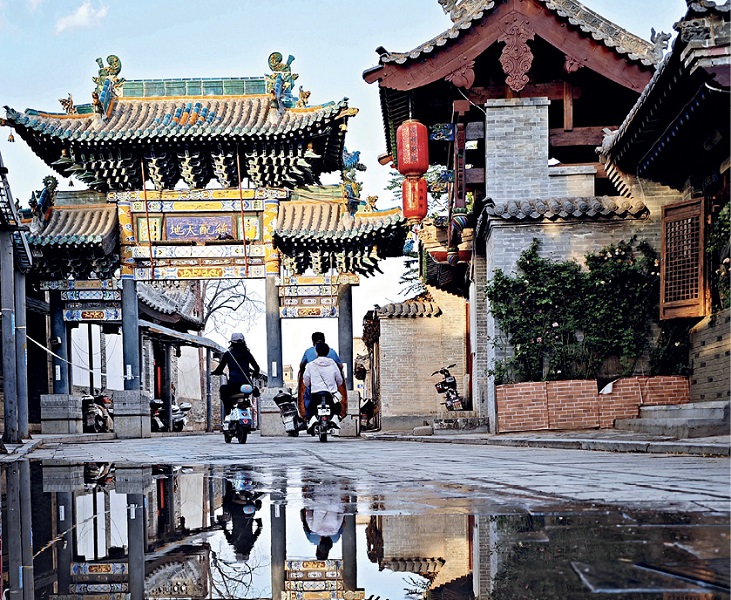
Several people waving dragon-patterned ribbons on the millennia-old city wall of Pingyao on January 9, 2024.
The ancient city of Pingyao is located in Pingyao County, Jinzhong City, central China’s Shanxi Province. It is considered one of the best-preserved ancient counties in China, dating back around 2,800 years to the Western Zhou Dynasty (1046 B.C.–771 B.C.). This county studded with historic constructions epitomizes the architectural techniques and city planning ideas used by ancient Chinese. It also reflects many features of China’s traditional political, ritual, and cultural practices as well as unique local culture of merchants, piaohao (private bank), and private security service.
This age-old city is a sizable architectural complex composed of numerous ancient streets, dwellings, temples, shops, and other buildings. It is laid out symmetrically with the South Main Street serving as the axis and the Market Tower as the central point. Taoist and Buddhist temples, ritual temples and government offices are arranged in compliance with the traditional layout design ideas rooted in Chinese feudal system of rites.
The city was built in the shape of a grid which consisted of four main streets and eight smaller streets, while another 72 alleys crisscross the city. More than 220 historic shops remain intact along the major streets, and there are over 3,980 ancient private residences with protection value, of which 506 have been well preserved.
In December 1997, the ancient city of Pingyao became one of two ancient Chinese cities inscribed on the World Heritage List of UNESCO. It has been a popular destination for tourists from home and abroad for decades. Around 20 attractions are open to the public, including the ancient city walls, Pingyao ancient county government office, City God Temple, Confucian Temple, and Rishengchang Piaohao.
Pinyao’s Ancient City Wall
The ancient city wall is a must-visit historic site in Pingyao. Here tourists can stroll along the imposing walls and have a panoramic view of the county’s landscape.
These city walls were constructed in a rectangular pattern with a perimeter of 6.2 kilometers. The walls are about 10 meters high, 8-12 meters wide at the base, and 2.5-6 meters wide at the top. There are six city gates, one in the north, one in the south, and two in the east and two in the west. They are equipped with 72 defense towers and 3,000 crenellations and merlons.
It is said that the history of these walls dates back to the Western Zhou Dynasty. The walls were originally built out of earth, then reinforced with bricks on the outside during the Ming Dynasty (1368-1644), as confirmed by an inscribed stone monument. This monument is still standing on the East Main Street in the ancient city of Pingyao, with an inscription describing the wall-reinforcing project carried out by the then county magistrate Meng Yimai. This well-preserved large-scale wall structure is significantly valuable for research and protection in terms of ancient military defense and architectural techniques.
A dazzling light show that is held every evening at the city walls provides viewers with a delightful experience created by the combination of modern technology with historic buildings.

An aerial view of the bustling main street in the ancient city of Pingyao on May 1, 2024.
Ancient County Government Office, City God Temple, and Confucian Temple
Inside the city walls, there are a number of sites of ancient government facilities and ritual relics.
Pingyao Ancient County Government Office is one of China’s best-preserved and largest ancient county government offices. Covering an area of approximately 26,000 square meters, it is a courtyard complex designed with six entries. Originally built during the Northern Wei Dynasty (386-534), the extant structures trace their origins back to the Ming and Qing (1368-1911) dynasties. According to ancient Chinese system of rites, its symmetrical layout is characterized by a central axis, which separates government departments in charge of personnel, revenue, and rites in the west , and those responsible for military, justice and engineering in the east.
Historical records document that 184 county magistrates assumed office at Pingyao from the Han Dynasty (206 B.C.-A.D. 220) to the late Qing Dynasty. This site bears witness to the long history of Pingyao as an administrative unit in China. Today, this government complex has been converted into a museum, and hosts performances that display the county magistrate’s daily tasks of inspection, case ruling, and the signing and issuing of “city-entry passes.”
City God Temple is another popular attraction in Pingyao. The City God, known as the local guardian god, was an important deity widely revered by the ancient Han people. This 7,300-square-meter temple is a time-honored Taoist temple used for official worship and is a textbook of rich historical and cultural traditions. The exact date of its construction is unknown, but it was rebuilt during the Ming and Qing dynasties after being destroyed in a fire.
A Confucian temple is located in the vicinity of the City God Temple. This temple dedicated to Confucius is the largest, best-preserved, and most distinctive of its kind in northern China.
Constructed during the early Tang Dynasty (618-907), it covers an area of 37,000 square meters. Its grand and stately design bears a strong resemblance to an imperial palace, fully reflecting people's reverence for Confucianism and emphasis on education at that time. With the exception of the Dacheng Hall which was built during the Jin Dynasty (1115-1234), the other buildings in the temple complex were built during the Ming and Qing dynasties.
The Market Tower was once the seat of the government department for regulating market activities. Today, visitors like to climb up to the top of the tower to enjoy the view of the surrounding county landscape.
Ma Family Compound
Rectangular courtyard houses enclosed with high walls are the most common residential building style in Pingyao. The Ma Family Compound is one of the signature traditional dwellings and is open to the public.
It once was the residence of a wealthy merchant named Ma Zhongxuan in the Qing Dynasty. Built during the late Qing Dynasty and expanded over the decades, it eventually developed into a 6,000-square-meter complex composed of three large courtyards and six small courtyards with over 190 rooms.
Exquisite and sophisticated architectural decorations, like carvings made out of brick, wood, and stone, can be seen everywhere. The complex still houses many precious antiques, such as finely carved and painted cabinets, beds, dressing mirrors, bathtubs, and other furniture pieces. The compound is fully equipped with halls, bedrooms, kitchens, study rooms, accounting rooms, pavilions, theatrical stages, and even a vinegar workshop and a personal security agency owned by the Ma family. By means of various textual displays, visitors can learn about the historical stories of the Ma family as they take a tour through the site.
Like most dwellings in Pingyao, the roofs of the east and west wing rooms in the compound are single-sloped, which help direct the rainwater to the courtyard. Additionally, according to this design, the outer walls are built higher, effectively blocking strong winds and sand.

Local residents riding down an ancient street between historic buildings in Pingyao on May 16, 2024.
Rishengchang Piaohao, Xietongqing Private Bank, and Private Security Agencies
The ancient city of Pingyao was once known as the “financial center” of China, where the country's first “private bank” – Rishengchang Piaohao – was established.
During the Ming and Qing dynasties, merchant groups emerged across the country and were named after the region they came from. Among them, the largest and most powerful was the Shanxi merchants. Most of people in Pingyao did business. They often had to carry large amounts of silver ingots, the prevailing currency at the time, with them from one place to another, which was very inconvenient. Piaohao services were born in this context.
Piaohao was a private financial institution that provided check, deposit and loan services. Rishengchang, the first piaohao in China, held a significant position in the history of Chinese commerce and financial development. The layout and appearance of Rishengchang during its peak period have been well preserved to this day. Today, it is a 2,400-square-meter museum that is open to the public. During the period from its establishment in 1823 to its shutdown during the early Republic of China, its business reached as far as Europe, America, and Southeast Asia. After Rishengchang was set up, 54 other piaohao houses emerged in China, 22 of which were headquartered in Pingyao.
Xietongqing Private Bank is another attraction known for its monetary roots. Founded in 1856, it had opened 33 branches by 1913 when it closed, having branches as far as Japan and Russia. It was one of the largest and fastest expanding piaohao houses in Shanxi. Covering an area of 2,880 square meters, it consisted of seven courtyards, with a massive safe in the backyard. Today, it is a public museum.
Being the “financial center” that it was, Pingyao once had many private security agencies (or biaoju) that provided protection for the transportation of items and services of guarding courtyards. The earliest private security business in China appeared during the reign of Emperor Qianlong of the Qing Dynasty and was founded by Zhang Heiwu from Pingyao. Zhang’s practice was known as Xinglong Biaoju. Subsequently, due to increasing demand, more security agencies were established, making great contributions to the commercial development and social stability in Pingyao and beyond. Today, in the ancient city of Pingyao, tourists can visit the China Biaoju Museum, the largest of its kind in north China, and Tongxinggong Biaoju, among other historical sites featuring the biaoju culture.
Nowadays, well-developed tourism services of transportation, accommodation, dining, and online ticket-purchasing are available in the ancient city of Pingyao. The ancient city also offers a range of new attractions by integrating modern cultural and technological elements, such as a dancing play adapted from a real piaohao story, 3D light displays, a tech-assisted immersive experience center, and traditional Chinese clothes experience halls. These modern services and creative activities help amplify the appeal and diversity of this ancient county, drawing more visitors to sample its cultural richness.